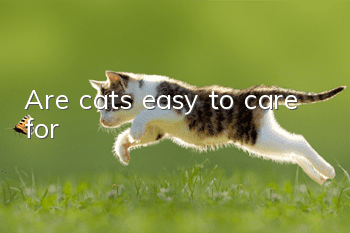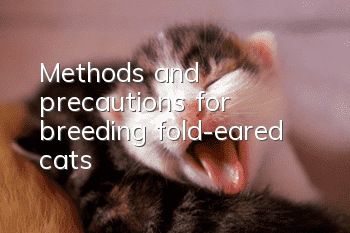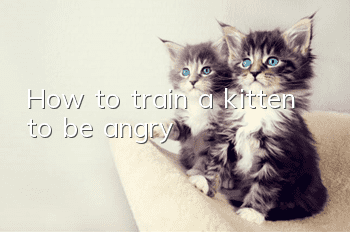How to choose cat litter for cats?

Migs are very clean animals, mainly because they are compared to dogs. Anyone who has ever raised a dog must have been troubled by the problem of dogs littering everywhere, and also worried about how to teach them to use the toilet. However, this kind of thing almost never happens to cats, because they are born to use cat litter! From about two months after birth, cats naturally learn how to use cat litter, burying their own urine and feces until they can no longer smell the smell and then leave with satisfaction.
1. Cats are born to use cat litter
This innate good habit is not actually because cats love to be clean, but is determined by their cautious nature. This can be traced back to the ancestors of cats a long time ago. Cats were originally wild, and then slowly Being domesticated. Their ancestors made a living by hunting when they lived in the wild. Contrary to the nature of dogs to pee everywhere and occupy the territory, cats are extremely cautious. They will even dig a hole in the sand when excreting feces, and then bury it to avoid Natural enemies or other animals detect their whereabouts. At the same time, burying feces can also prevent enemies from knowing their health status and not being attacked when they are sick. Are you so impressed by cats’ meticulous self-protection methods? It is said that although cats have been domesticated for a long time, they still maintain this excellent nature. Therefore, it is indispensable for us to raise cats today to use cat litter-that is, the sand used by their ancestors.
Many people who have never raised a cat say that there are cats on the Internet that use the toilet instead of cat litter, which saves worry and money and does not have to deal with cat litter and litter boxes! I sincerely advise you not to try to train your cat to use the toilet. If you don’t prepare cat litter and a litter box, your cat won’t have a fixed toilet, so it’s easy for your cat to develop the bad habit of urinating anywhere. What’s more serious is that your cat will urinate where it feels most at ease, such as your clothes or your sofa. , your bed. Training them to use the toilet? Are they so arrogant and willful that they will easily succumb to human intentions? Better save your energy.
2. Types and advantages and disadvantages of cat litter
Cat ancestors like to bury their excrement in fine, clean and dry soil, because smart cats know that it is easier to dig holes and bury in sandy soil, and the sand will not stick to their claws like soil. When cats gradually entered the family and became our pets and life partners, humans invented something to replace the sand in the wild - cat litter. Americans invented cat litter in 1948, and after more than 50 years of research and development, the quality of cat litter has become very high. There are more and more types of cat litter on the market, which often dazzles cat parents. Let’s introduce the common cat litters on the market. Cat litters with higher usage rates include bentonite sand, waterCrystal sand, pine sand/tofu sand/green tea sand/wheat sand, silica sand, and different types of cat litter combined with corresponding cat litter boxes will greatly improve the efficiency of cat litter use.
1. Bentonite cat litter
It is agglomerated cat litter. The main ingredients are bentonite and clay particles with montmorillonite as the main ingredient. The particle shapes include spherical, long strips and fine sand. Pour the bentonite sand into a single-layer cat litter box and spread it out. Keep the thickness between 7cm and 10cm. Just shovel out the caked urine and stool after each cleaning.
Bentonite sand is cheap, dry, fluffy, easy to bury, and the style is more in line with cats’ nature. It is the most easily accepted by all kinds of cats. It has always been a common choice for cat lovers around the world. Therefore, bentonite sand has occupied a large share of the international market. As much as 80%.
Advantages: Strong water absorption, good clumping ability, medium odor absorption effect, cheap price, easy to buy, and most easily accepted and used by cats.
Disadvantages: There is dust; the round particles are easy to get stuck in the cat's claws and be taken out of the litter box by the cat, and the ground needs to be cleaned frequently; there is a lot of fine sand-like dust; it cannot be flushed into the toilet and is very heavy.
2. Crystal cat litter
The main ingredients are silica gel particles and water-absorbent cat litter. It should be used in combination with a double-layer cat litter box. Spread the crystal sand on the filter, and lay a pee pad or other sand on the bottom layer to catch the cat urine that has not been absorbed and penetrated. If you use a single-layer cat litter box, the crystal sand If the sand is soaked in cat urine, it will be consumed quickly, which is wasteful.
Crystal sand will directly absorb the cat's urine, and then change from transparent to yellow without clumping. Just scoop out the poop. When 80% of the litter in the cat litter box has changed color, the cat litter can be replaced. Using crystal cat litter will save more than bentonite litter, and the cat litter particles are relatively large, making it difficult for cats to take them out of the cat toilet. It should be noted that some kittens like to play with this kind of sand. Since silica gel cannot be digested, there is a certain danger in ingestion.
Advantages: less dust; good water absorption and deodorization; less expensive than bentonite sand, easier to clean up; medium price.
Disadvantages: cannot be flushed into the toilet; individual cats may accidentally eat it and be in danger; it may cause secondary pollution.
3. Pine cat litter
Recycled pulp, hay, wood fiber/corn, wheat extract, etc. are crushed into powder and then pressed. After absorbing water, they are crushed into powder again. It is also necessary to use a double-layered cat litter box, with the lower layer connected with loose pine wood powder and wheat fiber powder. Each time you clean it, you only need to shake the upper screen to let the powder leak out. When the cat litter in the upper layer decreases, add it in time, and when there is more powder in the lower layer, clean it up in time.
After useThe pine wood sand powder can be poured directly into the toilet and flushed, and can also be poured into the garden or flower pots as flower fertilizer (if you don't mind the smell of cat urine), and it is relatively easy to clean up. However, in areas with high air humidity, you should pay attention to cleaning the cat litter box in time, because pine wood chips can easily breed bacteria in a humid environment.
Advantages: Strong water and odor absorption, almost no dust; not easy to be taken out of the litter box by cats; less expensive than bentonite sand and crystal sand, easier to clean, and can be flushed into the toilet.
Disadvantages: Bacteria can easily breed in humid weather in summer; the price is slightly expensive; some cats don’t like the smell of sawdust and refuse to use it inside.
4. Confetti cat litter
The main ingredient is reused paper products, and some paper cat litter also contains activated carbon. It is best to use a double-layer cat litter box. The upper layer is covered with paper sand, and the lower layer is covered with pee pads or other sand. Urine will penetrate from the upper layer to the lower layer. When cleaning, the upper and lower layers need to be cleaned at the same time.
Advantages: Strong water and odor absorption ability, no clumping, no dust; can be flushed into the toilet; not easy to be taken out of the litter box by cats; low chemical composition.
Disadvantages: Some products tend to become mushy after absorbing water and require more diligent cleaning; they are expensive.
5. Tofu sand
Although the main ingredients are bean dregs waste, corn cobs, etc., the production process is similar to that of pine sand, but like bentonite sand, they are clumping cat litter. Bean dregs have very good water solubility and can be poured directly into the toilet and melted quickly without worrying about clogging. In addition, the tofu litter is made of food-grade material, so cats don’t have to worry too much if they accidentally eat it.
Advantages: clumps, no dust; natural ingredients, suitable for purebred cats and cats with weak stomachs, especially suitable for postpartum and postoperative cats; can be flushed into the toilet.
Disadvantages: Bacterial parasites can easily breed in humid weather in summer; they are basically imported products and are expensive.
3. Cat’s litter habits
We already have a general understanding of the main types of cat litter on the market. Before introducing specific cat litter brand products, it is very necessary to popularize cats’ habits of using cat litter to avoid new cat owners having to pay a heavy price for cat litter. cost. After all, cat litter is bought for cats, and everything should be based on the cat’s preferences. Generally speaking, there are the following points that need special attention:
Scent-free cats have a very sensitive sense of smell. They rely on their sensitive sense of smell to judge the location of food storage and distinguish the nature of food; when courting, they can smell the smell of cats of the opposite sex hundreds of meters away; cats Mothers rely on their sense of smell to identify their babies; the first thing a kitten does after birth is to use its sense of smell to find its mother's nipples... so catsCats have a very sensitive sense of smell and are disgusted by what we call "scent". If you don't believe it, if you try to smell perfume for them, they will definitely squint their eyes in disgust, or even run away in disgust. If you don’t understand this, you are likely to buy scented cat litter because it can mask the stench of cat excrement, but be careful that your cat will be disgusted and refuse to use this litter! Pine wood sand inevitably has a natural pine wood smell, so many cats cannot accept it.
The dust should be less. Cats are used to smelling it after relieving themselves, so as not to feel disgusted. This is determined by their nature. Cat ancestors would bury their excrement in the wild and then smell it to ensure that there is no smell and will not be eaten. Natural enemies discovered. As mentioned above, cats’ noses are very sensitive. If there is a lot of dust in the cat litter, the cat will feel uncomfortable if it inhales too much dust. Therefore, some cats will sneeze after using the cat litter. I believe many cat friends have seen this. In addition, dust is absorbed into the cat's fur, which can cause allergies in severe cases. It can rub onto beds, sofas, and clothes, which can also affect the home environment.
The paws feel good, the particles are moderate, fluffy, and have a certain weight, close to the sand in the wild sandy soil. This is why bentonite sand is so popular among cats, while the particles of pine sand are very large, which makes cats more uncomfortable when scratching. It takes a lot of effort, and if things go on like this, it will become impossible to bury the stool.
The ingredients are healthy and do not contain too many chemical ingredients or additives. Cats are very sensitive from their sense of smell to their fur. Too many chemical additives can make cats resist their use or even cause allergies. You should be especially careful with cats who like to play with cat litter.
Strong coagulation power/strong water absorption The coagulation power is for clumping cat litter. It can quickly condense into clumps, making it easy to clean and reduce dust. If the coagulation power is average and easy to spread, it will be difficult to completely eradicate the urine mass. Then more and more litter stained with cat urine will remain in the litter box, and the smell will become stronger and stronger, which will also make the cat dislike and reject it. use. Water absorption is for water-absorbent cat litter. Crystal sand and pine sand absorb water quickly and efficiently, keeping the cat litter box dry. Otherwise, bacterial parasites can easily breed in humid conditions.
Don’t change cat litter frequently. Don’t change cat litter frequently! Once you decide on a type of cat litter, don't change it easily. Cats are very resistant to changes in the things around them, and may even be uneasy and afraid. Therefore, don't change the cat litter if you can. If you must change, please do it step by step, mixing the new cat litter with the old litter from a small amount to a large amount, and let the cat slowly get used to it and accept it until it is completely replaced.
- Can cats eat grapefruit?
- Why do Turkish Van cats need to be neutered?
- Why are Siamese cats getting darker and darker?
- What should I do if the corners of my cat’s mouth are broken?
- Kitten suddenly gasps like asthma
- How to read a cat’s thoughts and read a cat’s body language
- How to give medicine to cats?
- What is the best way for cats to grind their teeth?
- How to distinguish Siamese cat reversion from appearance problems? Characteristics of Siamese cats!
- Can cats eat pangasius?



